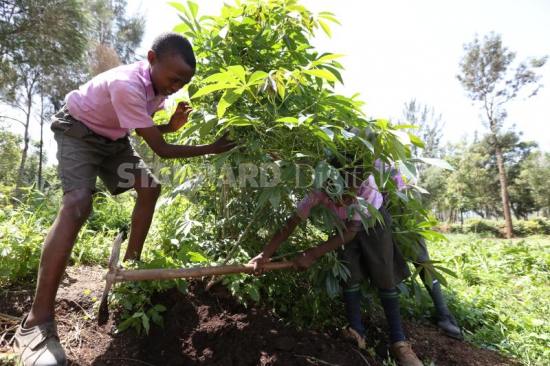
NAIROBI: Over the recent years, agriculture has increasingly lost its allure among school going students. Large numbers of students — especially those in rural areas — would want to leave the village and head to the cities after school.
Statistics show the average age of a coffee farmer is 65 years calling for the need to re-invigorate the youth to take up farming as a career. Increasingly, pressure has mounted on teachers and especially those in agriculture to make the subject attractive to the youth in primary and secondary schools.
In the past, punishment in schools was sometimes meted in form of manual work in the school compound or farms making many students view agriculture negatively. Recent education guidelines from the Ministry of Education have discouraged this practice. Currently, agriculture is taught in secondary schools as an elective subject with many students opting to drop it after Form Two.
Candidates who take up the subject have to carry out a year-long project where they grow a certain crop or raise livestock. This project is expected to translate the theoretical aspects of the subject into more practical and lasting experience for the candidates, many of whom may end up becoming future farmers.
However, it is the commercialisation of students’ farming activities that has really boosted increased interest in farming for the teenage students. In many schools, students are allowed to ‘own’ plots where they grow a variety of vegetables, notably cabbages, carrots or tomatoes. The produce is later sold to the school or to neighbouring communities - earning some income.
These activities are carried out at club level where officials may use the proceeds to organise or fund students’ excursion to national parks or visit to attractive sites at the Coast. While the money may seem the main motivation for learners, a number of them end up practising what they have learnt on their home plots, over the school holidays or immediately after leaving school.
Positive coverage of youthful and successful farmers in our mainstream media outlets has also motivated learners to embrace farming. Inspirational articles on farmers in their 20s and 30s who have succeeded in commercial smallholder farming is slowly changing the perception that farming is for the elderly and jobless.
Agriculture teachers in schools are using these articles as teaching and learning resources. Use of information technology is also allowing students to view videos and photographs of successful farmers.
While teachers would sometimes find it difficult to teach some sections of the syllabus due to lack of resources, it has now become easier even for students to download materials and critically examine these resources-making agriculture lessons interactive and interesting. Rural-based schools are now accessing online images of crops and livestock that are not raised in their home regions. Photographs and workings of farm tools and equipment which may not be available to schools can now be accessed cheaply and in colour.
Visits to agricultural shows— particularly the Nairobi International Trade Fair — where learners see first-hand farming activities, acts as a catalyst to future farmers. Agriculture teachers need to ensure that they move around the exhibitions stands and demonstration farms with their students so that classroom concepts can be actualised with the reality. Inviting successful youthful farmers to speak with students also helps to change perceptions.
The writer is an agriculture teacher and freelance journalist
 The Standard Group Plc is a
multi-media organization with investments in media platforms spanning newspaper
print operations, television, radio broadcasting, digital and online services. The
Standard Group is recognized as a leading multi-media house in Kenya with a key
influence in matters of national and international interest.
The Standard Group Plc is a
multi-media organization with investments in media platforms spanning newspaper
print operations, television, radio broadcasting, digital and online services. The
Standard Group is recognized as a leading multi-media house in Kenya with a key
influence in matters of national and international interest.
 The Standard Group Plc is a
multi-media organization with investments in media platforms spanning newspaper
print operations, television, radio broadcasting, digital and online services. The
Standard Group is recognized as a leading multi-media house in Kenya with a key
influence in matters of national and international interest.
The Standard Group Plc is a
multi-media organization with investments in media platforms spanning newspaper
print operations, television, radio broadcasting, digital and online services. The
Standard Group is recognized as a leading multi-media house in Kenya with a key
influence in matters of national and international interest.







